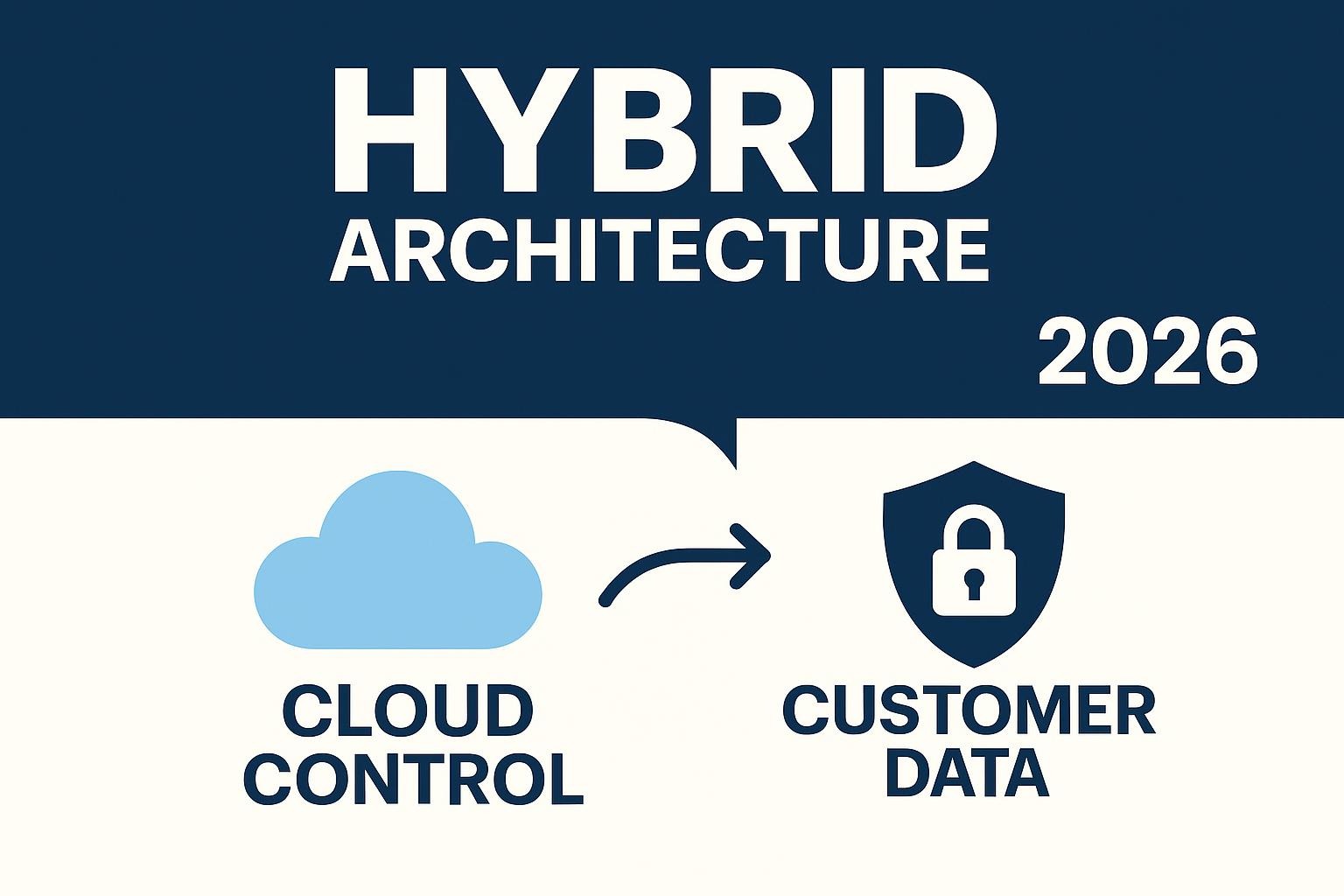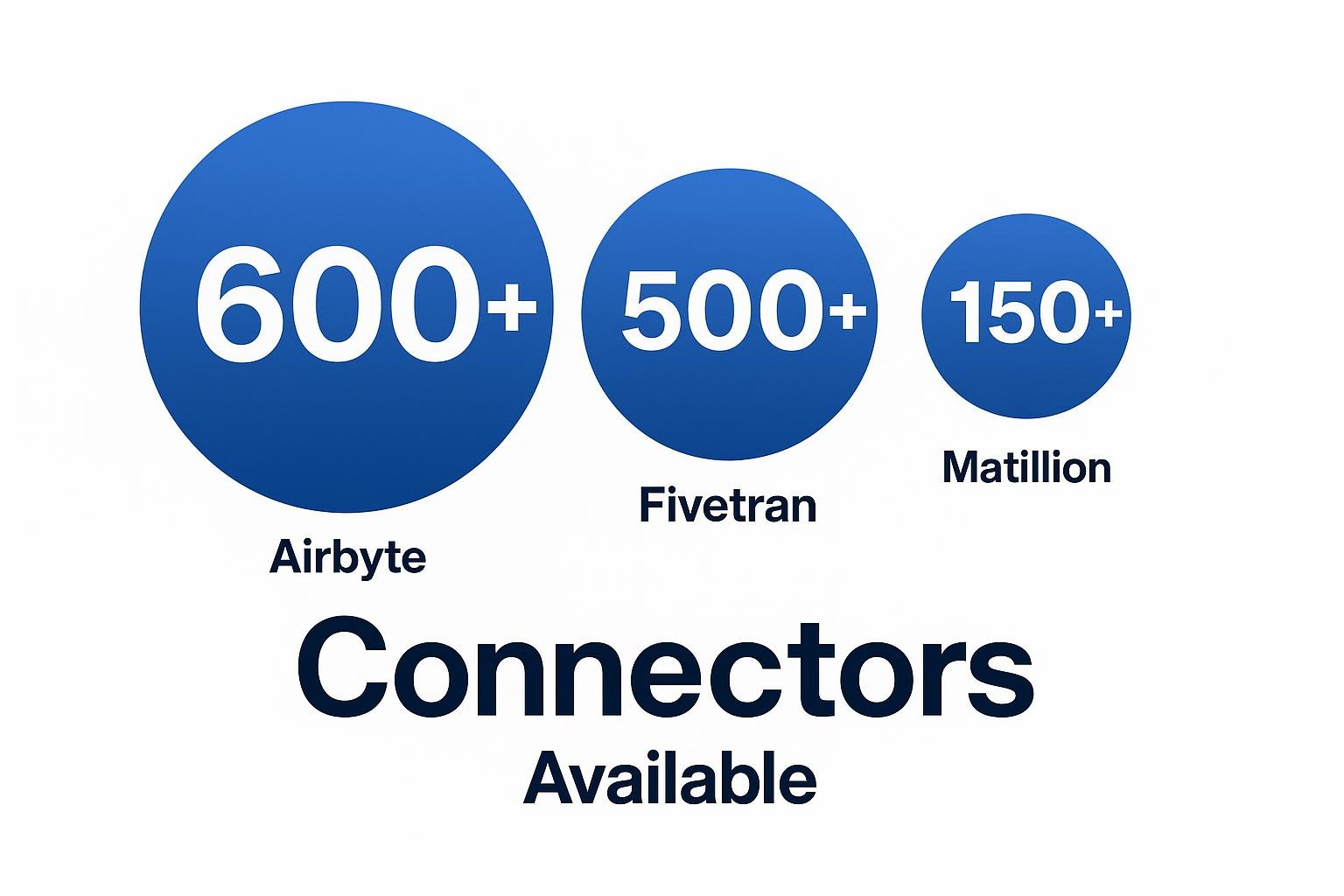7 Top Hybrid Deployments Solutions for 2026
Summarize this article with:
✨ AI Generated Summary
Enterprise data teams increasingly adopt hybrid deployment architectures that separate cloud-hosted control planes from customer-controlled data planes, enabling cloud elasticity while maintaining data sovereignty and regulatory compliance (e.g., GDPR, HIPAA). Key evaluation criteria for 2026 platforms include:
- Multi-cloud flexibility and strong security controls (encryption, MFA, RBAC)
- Scalability with elastic resource pools and cost predictability
- Unified management dashboards and compliance certifications (SOC 2, ISO 27001, HIPAA, FedRAMP)
Leading platforms differ in sovereignty guarantees, connector availability, operational complexity, and pricing; for example, Airbyte Enterprise Flex offers full data sovereignty with Kubernetes-based self-hosting, while Fivetran Hybrid provides simpler managed services with less customization. Choosing the right solution depends on workload risk profiles, compliance needs, and operational capabilities, with proof-of-concept testing recommended before commitment.
Data teams at enterprise companies spend their days juggling GDPR audits, HIPAA compliance checks, and cloud bills that spike every quarter. The solution most are adopting is hybrid architectures that separate cloud control planes from customer-owned data planes. You get cloud elasticity without sacrificing data sovereignty or regulatory control.
This approach runs orchestration in the cloud while your sensitive data stays exactly where you need it, whether on-premises or in your VPC.
What Defines a Modern Hybrid Deployment Solution?
When you evaluate hybrid deployment options for 2026, start with architecture. A modern platform separates a cloud-hosted control plane from a customer-controlled data plane, so orchestration happens centrally while your records never leave trusted infrastructure. This separation enables you to meet data sovereignty and cross-border compliance requirements.
The capabilities you should evaluate include:
- Flexibility across clouds: Interoperate with AWS, Azure, Google Cloud, and on-premises workloads, avoiding lock-in through multi-cloud architectures.
- Data sovereignty and compliance: Keep sensitive data in region, satisfy GDPR, HIPAA, and industry rules without building separate pipelines.
- Robust security controls: Encryption, MFA, and granular RBAC must align with enterprise standards for comprehensive security frameworks.
- Scalability and performance: Elastic resource pools and GPU support deliver the performance headroom needed for AI and analytics.
- Cost predictability: Usage-based pricing on elastic tiers pairs cloud bursts with steady on-premises footprints, controlling budget fluctuations.
- Unified management and automation: One dashboard for monitoring, policy enforcement, and CI/CD hooks replaces scattered tooling.
These capabilities align with regulations like GDPR and HIPAA. Data stays where law requires, workloads burst wherever capacity is cheapest, and a single dashboard shows you who accessed what. Modern hybrid deployment extends to edge clusters, letting production lines or branch clinics run identical connectors without re-architecture.
How Do 2026's Leading Hybrid Deployment Platforms Compare?
You'll find plenty of marketing noise around "hybrid," so this overview focuses on the facts that actually matter: where each platform runs, how it handles compliance, and what it costs to keep pipelines stable. Think of it as a quick-scan filter before diving into vendor specifics.
The matrix compares six core dimensions: deployment architecture, security posture, connector depth, pricing model, and industry fit. This way you can immediately rule platforms in or out based on your non-negotiables.
Use the deployment column to confirm your control-plane requirements first, then scan connector depth and compliance rows to ensure there's no feature trade-off for sovereignty. With your shortlist ready, let's evaluate each platform in detail.
Which Hybrid Deployment Solutions Lead in 2026?

Data teams waste months building compliance-ready pipelines only to discover their vendor's "hybrid" option still routes sensitive data through third-party clouds. The seven platforms below actually separate control from execution, but they differ wildly in how much sovereignty you keep, connector availability, and operational complexity.
1. Airbyte Enterprise Flex
Airbyte Enterprise Flex delivers the strongest data sovereignty guarantees. The cloud control plane handles orchestration while every data plane process runs in your Kubernetes clusters. You get outbound-only networking, external secrets managers, and 600+ connectors with zero feature trade-offs. Banks, hospitals, and manufacturers use this to achieve GDPR, HIPAA, or DORA compliance without code rewrites. The open-source foundation means custom connectors and no vendor lock-in.
The downside: you need Kubernetes expertise to scale workers and coordinate between control and data planes. Self-hosting shifts infrastructure operations entirely to your team.
2. Fivetran Hybrid
Fivetran Hybrid prioritizes simplicity over sovereignty depth. The vendor-managed control plane and VPC agents deliver 500+ curated connectors with automated upgrades and 24/7 monitoring. SOC 2 and HIPAA compliance come standard. Row-based pricing makes costs predictable.
The trade-off: limited customization. You cannot modify connector code or deploy fully on-premises. Premium tiers get expensive at scale, and you are locked into Fivetran's feature roadmap.
3. Matillion Hybrid Data Productivity Cloud
Matillion combines a SaaS designer with on-premises agents for fast analytics delivery. Drag-and-drop transformations and SQL-friendly interfaces give analysts a quick learning curve. Native integration with Snowflake, Redshift, and Databricks accelerates cloud-warehouse ELT. Private endpoints keep traffic inside your network.
Sovereignty controls lag enterprise competitors. The hybrid feature set is still maturing, and petabyte-scale CDC workloads perform poorly. Best for mid-market BI projects, not heavily regulated environments.
4. Talend Data Fabric
Talend offers maximum deployment flexibility. Containerized agents run on-premises, in private cloud, or alongside the SaaS control plane. You get integrated data quality, stewardship, and lineage in one governance layer. The connector library spans legacy mainframes to modern cloud APIs.
Comprehensive capabilities mean steep complexity. Full rollouts require multiple teams, Java developers, and months of configuration. Licensing costs escalate with each module, and implementation timelines stretch longer than alternatives.
5. Informatica IDMC
Informatica brings two decades of enterprise ETL credibility to hybrid deployments. Secure agents respect data residency while delivering enterprise-grade stability, comprehensive SLAs, and 1,000+ connectors. Rich metadata management, AI-powered catalogs, and deep lineage support regulatory audits. FedRAMP options serve government contractors.
High total cost of ownership and complex pricing are the downsides. Scaling requires license negotiations, not elastic provisioning. Feature velocity lags cloud-native platforms, and modernization moves at large-vendor speed.
6. Denodo Platform
Denodo virtualizes data instead of copying it. Query federation across existing stores plus intelligent caching minimizes data movement, simplifying compliance. Real-time access supports live analytics without batch delays. The caching layer reduces load on source systems.
Performance tuning becomes critical at petabyte scale. Query planning grows complex with multiple federated sources. Teams used to physical ETL face a conceptual shift, and the virtualization model struggles with bulk-load batch jobs.
7. IBM DataStage
IBM DataStage runs in Red Hat OpenShift clusters on-premises or in any major cloud as part of IBM Cloud Pak for Data. You get proven batch and real-time ETL plus AI-assisted job design. Deep integration with Watson and Db2 helps IBM-centric enterprises. OpenShift provides hybrid orchestration portability.
Heavy infrastructure footprint and complex licensing are drawbacks. Deployment demands significant Kubernetes resources. Vendor lock-in increases with IBM stack integration, and pricing follows traditional enterprise patterns instead of consumption-based models.
How to Choose the Right Hybrid Deployment Solution?

Finding the right hybrid deployment platform depends on knowing your workloads, compliance boundaries, and long-term scalability goals. These steps help you evaluate options with clarity and confidence.
Map Your Workloads and Risk Profile
Start by mapping your workloads and risk profile. Identify whether your goals center on regulated data, modernization, or cloud-native growth.
- Regulated enterprises handling sensitive data often fit best with Airbyte Enterprise Flex, Informatica, or Denodo.
- Mid-market teams focused on modernization tend to choose Matillion or Talend for their balance of capability and simplicity.
- Cloud-native organizations usually prefer Airbyte Enterprise Flex for deployment flexibility, while Fivetran suits fully managed cloud setups.
Examine Core Factors for Operational Success
Once you’ve narrowed your options, focus on what determines smooth day-to-day operations. Confirm that each vendor’s certifications meet your compliance needs (missing GDPR or HIPAA coverage rules a platform out immediately).
Review the control-plane design. A split model that keeps processing inside your perimeter ensures stronger data sovereignty than cloud-only setups. Check for open standards to avoid lock-in and calculate total cost of ownership, including connector fees and Kubernetes expertise, not just the license price.
Run a Proof of Concept on Real Pipelines
Before committing, test your shortlist in a controlled environment. Run a short proof of concept using a representative pipeline. Measure latency, connector reliability, and the staff time needed to keep jobs running smoothly. A week of testing will reveal which platform truly fits your team before you commit to a long-term contract.
What Does the 2026 Hold for Hybrid Deployment?
Modern enterprises no longer treat hybrid deployment as a compromise. It's become the standard for organizations that need cloud agility without sacrificing regulatory control. The platforms that succeed in 2026 are those that truly separate orchestration from execution, keeping sensitive data within your perimeter while delivering the full feature set teams expect.
Whether you prioritize complete sovereignty, managed simplicity, or specialized capabilities like data virtualization, the right hybrid architecture lets you scale confidently while staying compliant. The choice should land on the platform that best matches your sovereignty requirements and operational reality.
Airbyte Enterprise Flex delivers a hybrid architecture with complete data sovereignty, keeping your sensitive data in your VPC while feeding AI-ready pipelines for clinical, financial, or industrial use cases. Talk to Sales to discuss your hybrid deployment requirements.
Frequently Asked Questions
What is hybrid deployment and why does it matter for enterprise data?
Hybrid deployment runs a cloud control plane for orchestration while data processing happens in your own infrastructure. This architecture lets you meet data sovereignty requirements, satisfy GDPR or HIPAA mandates, and control where sensitive information lives, all while gaining cloud elasticity for non-sensitive workloads.
How does Airbyte Enterprise Flex ensure data sovereignty?
Airbyte Flex keeps your data plane completely within your Kubernetes clusters or VPC. Data never leaves your infrastructure during processing. The cloud control plane only handles orchestration, scheduling, and metadata, while all extraction, transformation, and loading happens in your environment using outbound-only connections.
What should I look for in a hybrid deployment platform for regulated industries?
Prioritize platforms with SOC 2, ISO 27001, and industry-specific certifications like HIPAA or FedRAMP. Verify that the architecture truly separates control from execution, supports external secrets management, provides comprehensive audit logging, and offers the deployment flexibility to keep data in your required regions without feature compromises.
How does hybrid deployment compare to fully managed cloud or on-premises solutions?
Hybrid deployment combines cloud convenience with on-premises control. You avoid the operational burden of managing a full control plane while retaining complete sovereignty over data processing. This model typically delivers lower total cost of ownership than fully self-managed systems and stronger compliance guarantees than cloud-only platforms.

